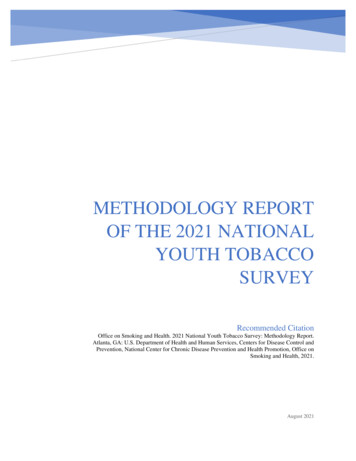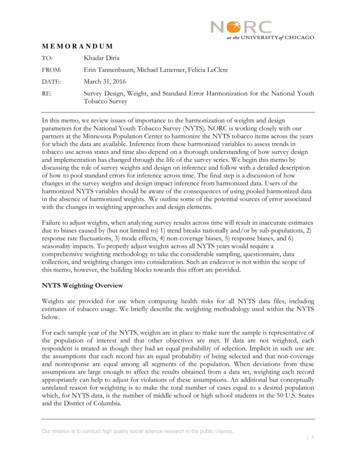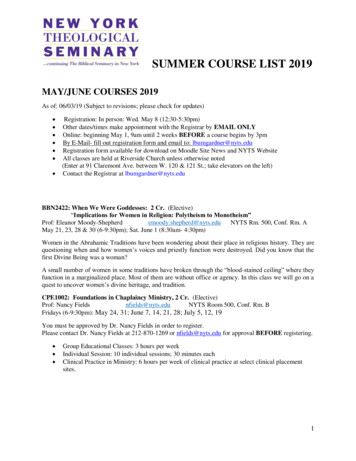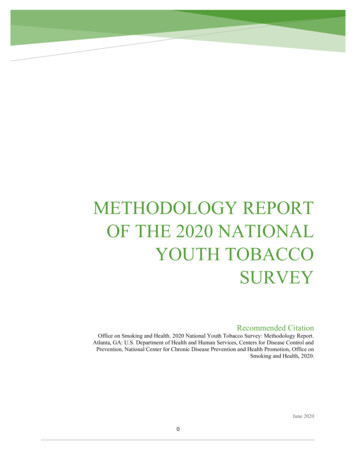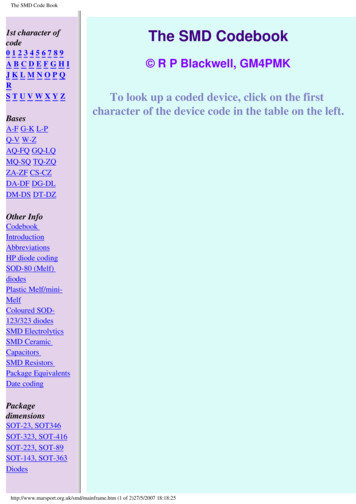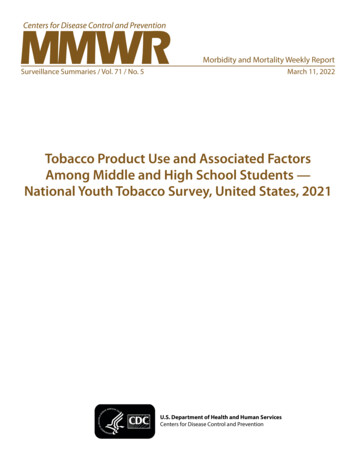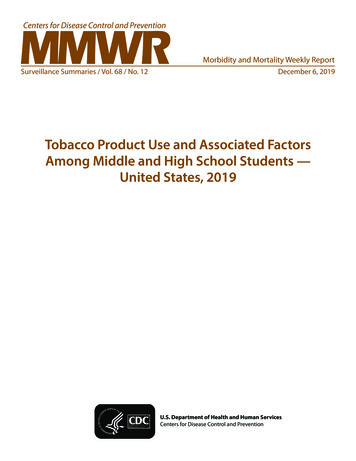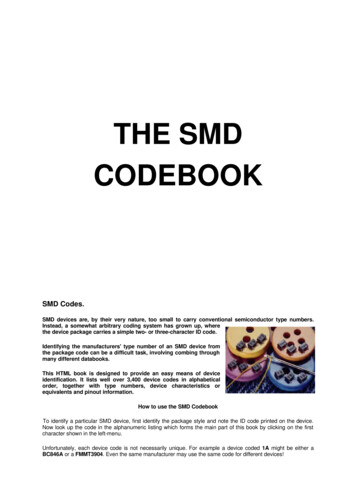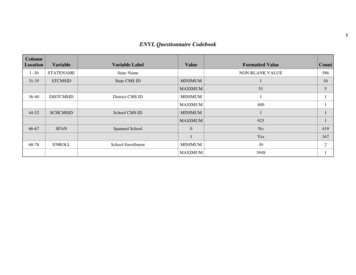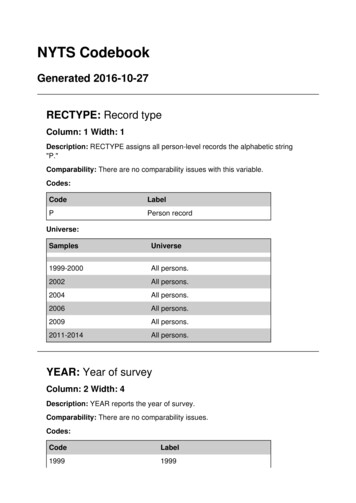
Transcription
NYTS CodebookGenerated 2016-10-27RECTYPE: Record typeColumn: 1 Width: 1Description: RECTYPE assigns all person-level records the alphabetic string"P."Comparability: There are no comparability issues with this variable.Codes:CodeLabelPPerson recordUniverse:SamplesUniverse1999-2000All persons.2002All persons.2004All persons.2006All persons.2009All persons.2011-2014All persons.YEAR: Year of surveyColumn: 2 Width: 4Description: YEAR reports the year of survey.Comparability: There are no comparability issues.Codes:CodeLabel19991999
verse1999-2000All persons2002All persons2004All persons2006All persons2009All persons2011-2014All personsSERIAL: Sequential serial numberColumn: 6 Width: 6Description: For all persons, SERIAL uniquely identifies NYTS respondentswithin a given year. For unique identifiers across all years of NYTS, users shouldcombine SERIAL with YEAR.Comparability: There are no comparability issues with this variable.Codes: SERIAL is a continuous variable.Universe:SamplesUniverse1999-2000All persons.
SamplesUniverse2002All persons.2004All persons.2006All persons.2009All persons.2011-2014All persons.STRATAORIG: Strata, original values with stringcharacters (for variance estimation)Column: 12 Width: 7Description: STRATAORIG reports the strata for variance estimation; this is theoriginal strata value from NYTS and may include string characters. Analysts mayalso be interested in the variable STRATANUM, which is an NYTS-modifiedversion of STRATAORIG to ensure that all values are numeric and appropriatefor variance estimation in statistical packages.Comparability: There are no comparability issues.Codes: STRATAORIG is a continuous variable.Universe:SamplesUniverse2002All persons.2004All persons.2006All persons.2009All persons.2011-2014All persons.STRATANUM: Numerical strata for varianceestimationColumn: 19 Width: 7Description: STRATANUM reports the sample strata for variance estimation.Analysts may also be interested in the variable STRATAORIG, reports theoriginal strata value from the NYTS, including string characters; STRATANUM is
an NYTS-modified version of STRATAORIG to ensure that all values are numericand appropriate for variance estimation in statistical packages.Comparability: There are no comparability issues.Codes: STRATANUM is a continuous variable.Universe:SamplesUniverse1999-2000All persons2002All persons2004All persons2006All persons2009All persons2011-2014All personsPSSTRATA: Psuedo strataColumn: 26 Width: 3Description: PSSTRATA reports the psuedo strata.Comparability: There are no comparability 5D108BWest5P109Mwest1D110Mwest1P
niverse:SamplesUniverse2002All persons.PSUORIG: Primary sampling unit, original values
Column: 29 Width: 10Description: PSUORIG reports the primary sampling unit for varianceestimation; this is the original primary sampling unit value from NYTS. Analystsmay also be interested in the variable PSUNUM, which is an NYTS-modifiedversion of PSUORIG to ensure that all values are numeric and appropriate forvariance estimation in statistical packages.Comparability: There are no comparability issues.Codes: PSUORIG is a continuous variable.Universe:SamplesUniverse2002All persons.2004All persons.2006All persons.2009All persons.2011-2014All persons.PSUNUM: Numerical primary sampling unit forvariance estimationColumn: 39 Width: 10Description: PSUNUM reports the numerical primary sampling unit for varianceestimation. Analysts may also be interested in the variable PSUORIG, whichreports the original primary sampling unit value from the NYTS; PSUNUM is anNYTS-modified version of PSUORIG to ensure that all values are numeric andappropriate for variance estimation in statistical packages.Comparability: There are no comparability issues.Codes: PSUNUM is a continuous variable.Universe:SamplesUniverse1999-2000All persons.20022004
SamplesUniverse200620092011-2014PSPSU: Psuedo primary sampling unitColumn: 49 Width: 8Description: PSPSU reports the psuedo primary sampling unit.Comparability: There are no comparability issues.Codes: PSPSU is a continuous variable.Universe:SamplesUniverse2002All persons.SCHLID: School identifierColumn: 57 Width: 12Description: SCHLID reports the school identifier.Comparability: There are no comparability issues with this variable.Codes: SCHLID is a continuous variable.Universe:SamplesUniverse2009All persons.2011-2014All persons.STUDID: Student identifierColumn: 69 Width: 9
Description: STUDID is a unique student identifier. Analysts may also choose touse SERIAL, an IPUMS-generated unique identifier for use within each surveyyear.Comparability: There are no comparability issues.Codes: STUDID is a continuous variable.Universe:SamplesUniverse1999-2000All persons2002All persons2004All persons2006All persons2009All persons2011-2014All personsSAMPSRC: Sample sourceColumn: 78 Width: 1Description: SAMPSRC reports the sample source. The 2002 NYTS includedboth a drawn and a panel sample; the harmonized NYTS includes the fullsample; SAMPSRC can be used to differentiate the drawn and panel subsamples. Note that analyses using these sub-samples should be weightedaccordingly.Comparability: There are no comparability issues with this variable.Codes:CodeLabel1Drawn sample2Panel sampleUniverse:SamplesUniverse2002All persons.
PERWT: Fully adjusted analysis weightColumn: 79 Width: 18Description: PERWT reports the fully adjusted analysis weight. Please see theComparability Tab for key information on changes to how this variable is scaledover time.Comparability: In the 1999 and 2000 NYTS samples, the weights were scaledso that the sum of all weights included would equal the sample size of the survey,while surveys fielded in 2002 and later were scaled to the total populationtargeted by the survey instead. Though this change does not affect calculatedproportions using only a single year of data, it does affect analyses that combinemultiple years of data across this change in scaling and calculations of weightedtotals in these years. The provided weights in 1999 and 2000 can be madecomparable to later years of the survey if multiplied by a constant to scale themto the population size. Detailed information on how to re-scale weights isavailable in practical application weighting memo.Codes: PERWT is a continuous variable.Universe:SamplesUniverse1999-2000All persons.2002All persons.2004All persons.2006All persons.2009All persons.2011-2014All persons.DRAWWT: Drawn sample weightColumn: 97 Width: 16Description: DRAWWT reports the drawn sample weight. The 2002 NYTSincluded both a drawn and a panel sample; DRAWWT is appropriate for analysesthat use only the drawn sample. The full 2002 sample is included; analystsinterested in restricting the sample to only the drawn or panel sample may usethe variable SAMPSRC.Comparability: There are no comparability issues with this variable.
Codes: DRAWWT is a continuous variable.Universe:SamplesUniverse2002All persons.PANWT: Panel sample weightColumn: 113 Width: 16Description: PANWT reports the panel sample weight. The 2002 NYTS includedboth a drawn and a panel sample; PANWT is appropriate for analyses that useonly the panel sample. The full 2002 sample is included; analysts interested inrestricting the sample to only the drawn or panel sample may use the variableSAMPSRC.Comparability: There are no comparability issues with this variable.Codes: PANWT is a continuous variable.Universe:SamplesUniverse2002All persons.MONTH: Month of surveyColumn: 129 Width: 2Description: MONTH reports the month in which the survey was administered.Comparability: There are no comparability ng response
Universe:SamplesUniverse2004All persons.2006All persons.DAY: Day of surveyColumn: 131 Width: 2Description: DAY reports which day of the month the survey was administered.A number of respondents reported values for DAY of zero or that are higher than"31"; these have been recoded to "missing" as they do not provide legitimatedates.Comparability: The variable is comparable over 121313141415151616
6All persons.ADMINWHO: Who administered surveyColumn: 133 Width: 2Description: ADMINWHO reports who administered survey: school staff or adata collector.Comparability: There are no comparability issues with this variable.Codes:CodeLabel1Teacher or other staff2Data collector
CodeLabel98Missing responseUniverse:SamplesUniverse2004All persons.2006All persons.ADMINWHEN: When survey was administeredColumn: 135 Width: 2Description: ADMINWHEN reports whether the survey was administered in theoriginal session or in a make-up session.Comparability: There are no comparability issues with this variable.Codes:CodeLabel1Original session2Make up session98Missing responseUniverse:SamplesUniverse2004All persons.2006All persons.AGE: AgeColumn: 137 Width: 2Description: AGE reports the age of the respondent. See the Comparability Tabfor more information on changes to available response categories over time.Comparability: The values of age are comparable from 1999-2009. Beginning in2011, rather than having response categories for "20" and "21", the top codechanged to "19 years old or older". Analysts may combine the categories for "19",
"20" and "21" in earlier years to maximize comparability with the 2011-forwardsamples. Otherwise, there are no comparability issues with this 1616171718181919 years (or older beginning in 2011)2020212198Missing responseUniverse:SamplesUniverse1999-2000All persons.2002All persons.2004All persons.2006All persons.2009All persons.2011-2014All persons.SEX: SexColumn: 139 Width: 2Description: SEX indicates whether the respondent was male or female.
Comparability: There are no comparability issues.Codes:CodeLabel1Female2Male98Missing responseUniverse:SamplesUniverse1999-2000All persons.2002All persons.2004All persons.2006All persons.2009All persons.2011-2014All persons.RACEAIAN: Selected American Indian-AlaskanNative as raceColumn: 141 Width: 2Description: RACEAIAN reports whether a respondent considers themselves tobe American Indian-Alaskan Native.Note on the construction of thisvariable:Respondents were asked how they describe themselves and told toselect all options that apply. Respondents could select multiple options.Respondents who selected this option are recorded as responding "yes" toidentifying as this race; respondents who did not select this response option arerecorded as responding "no".It is possible that these blank or unselectedresponses include respondents who simply did not answer the question, ratherthan respondents who were actively responding "no" to identifying as this race.To minimize the number of miscategorized "no" responses, persons who did notselect any of the available response categories have been recoded to having an"Inferred missing response". However, "no" responses to this variable arepossibly still overestimated by the question.Changes in available responsecategories affect the way in which the "inferred missing response" category isassigned over time. See the Comparability Tab for more details.
Comparability: In 1999-2002, the survey question that generates this variableincluded Hispanic or Latino. In 2004, the question about Hispanic or Latinoethnicity was moved to a separate question and no longer included as an optionfor the survey question on race. The number of missing responses increasedconsiderably with this shift. To be reclassified as having an "inferred missingresponse" in 2004-forward, the respondent must have all blank responses to thesurvey question on race AND the a blank or negative response to the separatequestion about Hispanic or Latino ethnicity. Persons who did not select anycategory in response to the race question, but answered the Hispanic or Latinoethnicity question affirmatively are coded as responding "no" rather than an"inferred missing response" to this variable.Codes:CodeLabel1No, this response option not selected2Yes99Inferred missing responseUniverse:SamplesUniverse1999-2000All persons.2002All persons.2004All persons.2006All persons.2009All persons.2011-2014All persons.RACEASIAN: Selected Asian as raceColumn: 143 Width: 2Description: RACEASIAN reports whether a respondent considers themselvesAsian.Note on the construction of this variable:Respondents were asked howthey describe themselves and told to select all options that apply. Respondentscould select multiple options. Respondents who selected this option are recordedas responding "yes" to identifying as this race; respondents who did not selectthis response option are recorded as responding "no".It is possible that theseblank or unselected responses include respondents who simply did not answerthe question, rather than respondents who were actively responding "no" to
identifying as this race. To minimize the number of miscategorized "no"responses, persons who did not select any of the available response categorieshave been recoded to having an "Inferred missing response". However, "no"responses to this variable are possibly still overestimated by thequestion.Changes in available response categories affect the way in which the"inferred missing response" category is assigned over time. See theComparability Tab for more details.Comparability: In 1999-2002, the survey question that generates this variableincluded Hispanic or Latino. In 2004, the question about Hispanic or Latinoethnicity was moved to a separate question and no longer included as an optionfor the survey question on race. The number of missing responses increasedconsiderably with this shift. To be reclassified as having an "inferred missingresponse" in 2004-forward, the respondent must have all blank responses to thesurvey question on race AND the a blank or negative response to the separatequestion about Hispanic or Latino ethnicity. Persons who did not select anycategory in response to the race question, but answered the Hispanic or Latinoethnicity question affirmatively are coded as responding "no" rather than an"inferred missing response" to this variable.Codes:CodeLabel1No, this response option not selected2Yes99Inferred missing responseUniverse:SamplesUniverse1999-2000All persons.2002All persons.2004All persons.2006All persons.2009All persons.2011-2014All persons.RACEBLK: Selected black or African American asraceColumn: 145 Width: 2
Description: RACEBLK reports whether the respondent considers themselvesBlack or African American.Note on the construction of this variable:Respondentswere asked how they describe themselves and told to select all options thatapply. Respondents could select multiple options. Respondents who selected thisoption are recorded as responding "yes" to identifying as this race; respondentswho did not select this response option are recorded as responding "no".It ispossible that these blank or unselected responses include respondents whosimply did not answer the question, rather than respondents who were activelyresponding "no" to identifying as this race. To minimize the number ofmiscategorized "no" responses, persons who did not select any of the availableresponse categories have been recoded to having an "Inferred missingresponse". However, "no" responses to this variable are possibly stilloverestimated by the question.Changes in available response categories affectthe way in which the "inferred missing response" category is assigned over time.See the Comparability Tab for more details.Comparability: In 1999-2002, the survey question that generates this variableincluded Hispanic or Latino. In 2004, the question about Hispanic or Latinoethnicity was moved to a separate question and no longer included as an optionfor the survey question on race. The number of missing responses increasedconsiderably with this shift. To be reclassified as having an "inferred missingresponse" in 2004-forward, the respondent must have all blank responses to thesurvey question on race AND the a blank or negative response to the separatequestion about Hispanic or Latino ethnicity. Persons who did not select anycategory in response to the race question, but answered the Hispanic or Latinoethnicity question affirmatively are coded as responding "no" rather than an"inferred missing response" to this variable.Codes:CodeLabel1No, this response option not selected2Yes99Inferred missing responseUniverse:SamplesUniverse1999-2000All persons.2002All persons.2004All persons.2006All persons.2009All persons.
SamplesUniverse2011-2014All persons.RACENHPI: Selected Native Hawaiin Pacific Islanderas raceColumn: 147 Width: 2Description: RACENHPI reports whether a respondent considers themselves tobe Native Hawaiian or other Pacific Islander.Note on the construction of thisvariable:Respondents were asked how they describe themselves and told toselect all options that apply. Respondents could select multiple options.Respondents who selected this option are recorded as responding "yes" toidentifying as this race; respondents who did not select this response option arerecorded as responding "no".It is possible that these blank or unselectedresponses include respondents who simply did not answer the question, ratherthan respondents who were actively responding "no" to identifying as this race.To minimize the number of miscategorized "no" responses, persons who did notselect any of the available response categories have been recoded to having an"Inferred missing response". However, "no" responses to this variable arepossibly still overestimated by the question.Changes in available responsecategories affect the way in which the "inferred missing response" category isassigned over time. See the Comparability Tab for more details.Comparability: In 1999-2002, the survey question that generates this variableincluded Hispanic or Latino. In 2004, the question about Hispanic or Latinoethnicity was moved to a separate question and no longer included as an optionfor the survey question on race. The number of missing responses increasedconsiderably with this shift. To be reclassified as having an "inferred missingresponse" in 2004-forward, the respondent must have all blank responses to thesurvey question on race AND the a blank or negative response to the separatequestion about Hispanic or Latino ethnicity. Persons who did not select anycategory in response to the race question, but answered the Hispanic or Latinoethnicity question affirmatively are coded as responding "no" rather than an"inferred missing response" to this variable.Codes:CodeLabel1No, this response option not selected2Yes99Inferred missing responseUniverse:
SamplesUniverse1999-2000All persons.2002All persons.2004All persons.2006All persons.2009All persons.2011-2014All persons.RACEWHT: Selected white as raceColumn: 149 Width: 2Description: RACEWHT reports whether the respondent listed white as theirrace.Note on the construction of this variable:Respondents were asked how theydescribe themselves and told to select all options that apply. Respondents couldselect multiple options. Respondents who selected this option are recorded asresponding "yes" to identifying as this race; respondents who did not select thisresponse option are recorded as responding "no".It is possible that these blank orunselected responses include respondents who simply did not answer thequestion, rather than respondents who were actively responding "no" toidentifying as this race. To minimize the number of miscategorized "no"responses, persons who did not select any of the available response categorieshave been recoded to having an "Inferred missing response". However, "no"responses to this variable are possibly still overestimated by thequestion.Changes in available response categories affect the way in which the"inferred missing response" category is assigned over time. See theComparability Tab for more details.Comparability: In 1999-2002, the survey question that generates this variableincluded Hispanic or Latino. In 2004, the question about Hispanic or Latinoethnicity was moved to a separate question and no longer included as an optionfor the survey question on race. The number of missing responses increasedconsiderably with this shift. To be reclassified as having an "inferred missingresponse" in 2004-forward, the respondent must have all blank responses to thesurvey question on race AND the a blank or negative response to the separatequestion about Hispanic or Latino ethnicity. Persons who did not select anycategory in response to the race question, but answered the Hispanic or Latinoethnicity question affirmatively are coded as responding "no" rather than an"inferred missing response" to this variable.Codes:
CodeLabel1No, this response option not selected2Yes99Inferred missing responseUniverse:SamplesUniverse1999-2000All persons.2002All persons.2004All persons.2006All persons.2009All persons.2011-2014All persons.RACESING: Single raceColumn: 151 Width: 2Description: RACESING reports which race group the respondent considersdescribes them best. Respondents could choose from a list of groups and couldonly select one response. An NYTS-recoded version of a respondent's race isavailable in the variable RACESINGR.Comparability: There are no comparability issues.Codes:CodeLabel1American Indian or Alaska Native2Asian3Black or African American4Hispanic or Latino5Native Hawaiian or Other Pacific Islander6White98Missing responseUniverse:
SamplesUniverse1999-2000All persons.2002All persons.RACESINGR: CDC/NYTS Recode: Single raceColumn: 153 Width: 2Description: RACESINGR is a NYTS-recoded variable that reports therespondent's race/ethnicity in a single race, without a multiple race category. Asimilar variable, NYTS-recoded variable, RACEMR, reports the respondent's raceand ethnicity, including the multiple race response category.The public use NYTSfiles do not include documentation on how CDC/NYTS-recoded variables wereconstructed. See below for observations about how these variables differ fromthe non-recoded versions in the original public-use files.This variable collates theresponse to the select-all-that-apply race question with the respondent's answerto the ethnicity question. It is unclear how persons who reported multiple racesare categorized in this variable.Comparability: This variable is presumed to be comparable over time; however,the lack of information on decisions behind the NYTS recoding choices makesthis difficult to determine.Codes:CodeLabel1Non-Hispanic American Indian or Alaska Native2Non-Hispanic Asian3Non-Hispanic Black or African American4Hispanic or Latino5Non-Hispanic Native Hawaiian or Other Pacific Islander6Non-Hispanice White98Missing responseUniverse:SamplesUniverse1999-2000All persons.2002All persons.2004All persons.
SamplesUniverse2006All persons.2009All persons.2011-2014All persons.RACEMR: CDC/NYTS Recode: race/ethnicity withmultiple race categoryColumn: 155 Width: 2Description: RACEMR is a NYTS-recoded variable that reports the respondent'smutually exclusive race and ethnicity with a multiple race category. A similarvariable, NYTS-recoded variable, RACESINGR, reports the respondent's raceand ethnicity, without the multiple race response category.The public use NYTSfiles do not include documentation on how CDC/NYTS-recoded variables wereconstructed. See below for observations about how these variables differ fromthe non-recoded versions in the original public-use files.This variable collates theresponse to the select-all-that-apply race question with the respondent's answerto the ethnicity question. If the respondent selected multiple race categories, theyare included in the "Multiple Races" response category.Comparability: This variable is presumed to be comparable over time; however,the lack of information on decisions behind the NYTS recoding choices makesthis difficult to determine.Codes:CodeLabel1Non-Hispanic White2Non-Hispanic Black3Hispanic4Non-Hispanic Asian5Non-Hispanic American Indian/Alaskan Native6Non-Hispanic Native Hawaiin or Other Pacific Islander7Multiple Races98Missing responseUniverse:SamplesUniverse
SamplesUniverse1999-2000All persons.2002All persons.2004All persons.2006All persons.2009All persons.2011-2014All persons.RACENUM: CDC/NYTS Recode: number of racesreportedColumn: 157 Width: 1Description: RACENUM reports the number of races the respondent selectedwhen asked how they identify.Analysts may prefer to use the variable RACEMR,which reports the respondent's race with a "multiple race" category and isavailable in all survey years.Comparability: There are no comparability issues with this variable.Codes:CodeLabel0No race chosen11 race chosen22 races chosen33 races chosen44 races chosen55 races chosen66 races chosenUniverse:SamplesUniverse2002All persons.HISPYN: Hispanic ethnicity, dichotomous
Column: 158 Width: 2Description: HISPYN is a dichotomous variable for whether the respondentidentifies with Hispanic ethnicity.Beginning in 2011, additional detail on arespondent's Hispanic is available in the following variables: HISPMEX,HISPPUER, HISPCUB, HISPOTH.Comparability: The way in which respondents were asked about Hispanicethnicity has changed over the course of the NYTS.In 1999-2002, persons wereasked a single question about race and ethnicity where they could select multipleoptions, and a follow up question asking which singular option described thembest. Hispanic or Latino was included in the list along with "American Indian orAlaska Native", "Asian", "Black or African American", "Native Hawaiian or OtherPacific Islander", "White", and "Other". HISPYN in 1999-2002 indicates that theperson reported "Hispanic or Latino" in the select-all question item and does notrequire that they selected this response in the follow up question about whichbest describes them.Beginning in 2004, the survey posed a dichotomousquestion; in 2004 about having "Spanish or Hispanic origin", then modifies thelanguage to ask about being "Hispanic or Latino" in 2006.For 2011 and 2012, thequestion became multiple choice and respondents could provide additional detailabout their Hispanic ethnicity, but could only select a single option choosingbetween "Mexican", "Puerto Rican", "Cuban", or "Other".Since 2013 respondentsmay select multiple categories in response to this question.HISPYN categorizesany response indicating Hispanic ethnicity as a "yes" except in 2013-forward, forpersons who replied inconsistently (e.g., persons who indicated that they wereboth not Hispanic and Cuban are assigned to an "Inconsistent combination"category.)The changes in question phrasing and response categories may affectthe comparability of this variable over time. Users should exercise caution andclosely explore the Survey Text Tab for full questionnaire text for this variableover time.Codes:CodeLabel10No11No, this response option not selected20Yes95Inconsistent combination of responses98Missing response99Inferred missing response (1999-2002)Universe:SamplesUniverse
SamplesUniverse1999-2000All persons.2002All persons.2004All persons.2006All persons.2009All persons.2011-2014All persons.HISPMEX: Hispanic ethnicity: Mexican, MexicanAmerican, ChicanoColumn: 160 Width: 2Description: HISPMEX indicates whether a respondent is Mexican, MexicanAmerican, or Chicano.Please see the Comparability Tab for more information onchanges to this variable over time.Comparability: The changes in question phrasing and response categories mayaffect the comparability of this variable over time.For 2011 and 2012,respondents could report their Hispanic or Latino ethnicity by identifying as"Mexican, Mexican American, Chicano or Chicana" as one of four "yes"options.Since 2013, respondents may select multiple categories in response totheir Hispanic, Latino, or Spanish origin. A respondent may identify as "Mexican,Mexican American, Chicano or Chicana" in addition to other options whichinclude Puerto Rican (HISPPUER), Cuban or Cuban American (HISPCUB), andsome other Hispanic identity not listed (HISPOTH).In 2013-forward, HISPMEXrecategorizes persons who replied inconsistently (e.g., persons who indicatedthat they were both "not Hispanic" and "Mexican") to an "Inconsistentcombination" category.Users should exercise caution and closely explore theSurvey Text Tab for full questionnaire text for this variable over time.Codes:Code Label10No, not Hispanic11No, not Mexican, Mexican American, or Chicano20Yes, Mexican, Mexican American, or Chicano21Yes, only Mexican, Mexican American, or Chicano22Yes, includes Mexican, Mexican American, or Chicano
Code Label95Inconsistent combination, includes Mexican, Mexican American, orChicano96Inconsistent combination, does NOT include Mexican, Mexican American,or Chicano98Missing response99Inferred missing responseUniverse:SamplesUniverse2011-2014All persons.HISPPUER: Hispanic ethnicity: Puerto RicanColumn: 162 Width: 2Description: HISPPUER indicates whether a respondent is Puerto Rican.Pleasesee the Comparability Tab for more detail on changes to the variable over time.Comparability: The changes in question phrasing and response categories mayaffect the comparability of this variable over time.For 2011 and 2012,respondents could report their Hispanic or Latino ethnicity by identifying as"Puerto Rican" as one of four "yes" options.Since 2013, respondents may selectmultiple categories in response to t
The 2002 NYTS included both a drawn and a panel sample; the harmonized NYTS includes the full sample; SAMPSRC can be used to differentiate the drawn and panel sub-samples. Note that analyses using these sub-samples should be weighted accordingly. Comparability: There are no comparability issues with this variable. Codes: Code Label 1 Drawn sample

